Satas D., Tracton A.A. (ed.). Coatings Technology Handbook
Подождите немного. Документ загружается.

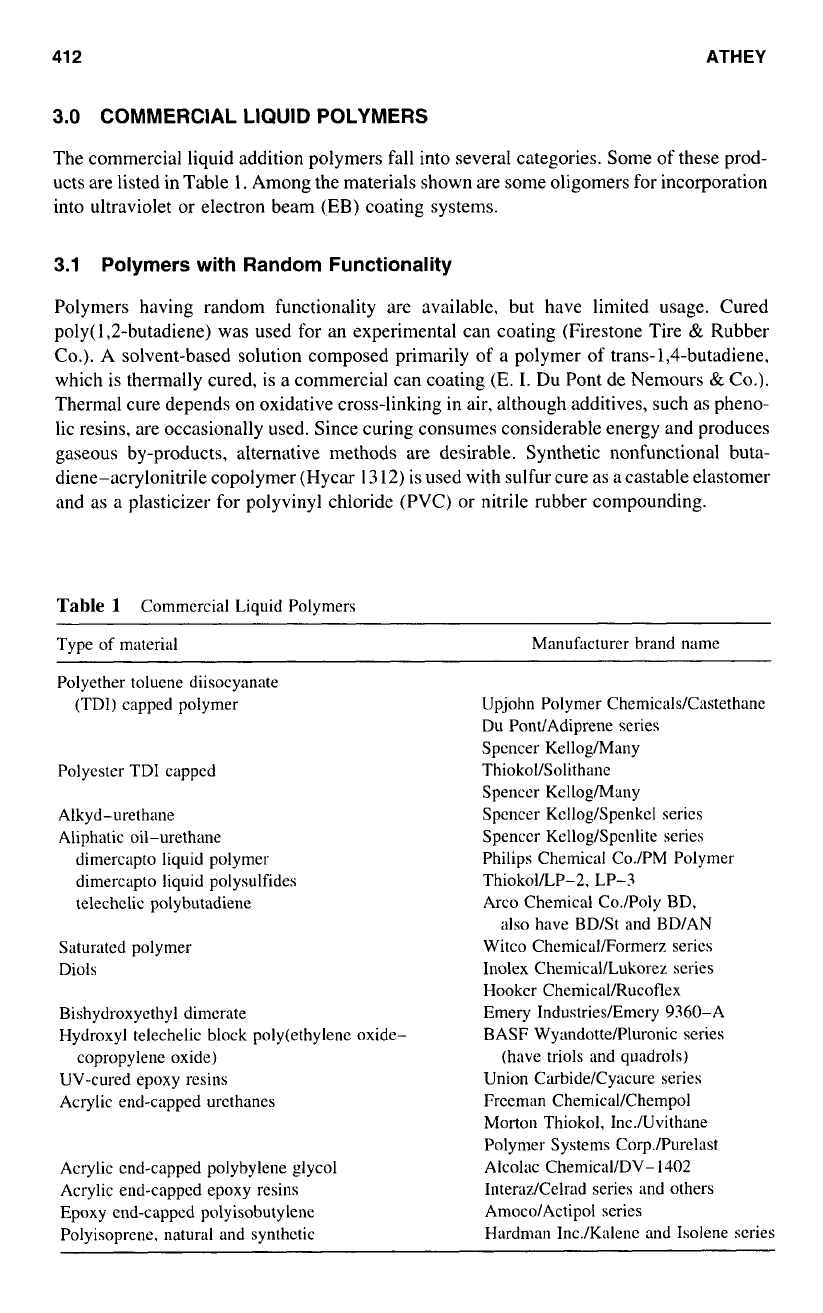
41
2
ATHEY
3.0
COMMERCIAL LIQUID POLYMERS
The commercial liquid addition polymers fall into several categories. Some of these prod-
ucts are listed in Table
1.
Among the materials shown are some oligomers for incorporation
into ultraviolet
or
electron beam
(EB)
coating systems.
3.1
Polymers with Random Functionality
Polymers having random functionality are available, but have limited usage. Cured
poly(l,2-butadiene) was used for an experimental can coating (Firestone Tire
&
Rubber
Co.).
A
solvent-based solution composed primarily of
a
polymer
of
trans-1,4-butadiene,
which is thermally cured, is a commercial can coating
(E.
I.
Du Pont de Nemours
&
Co.).
Thermal cure depends
on
oxidative cross-linking in air, although additives, such
as
pheno-
lic resins, are occasionally used. Since curing consumes considerable energy and produces
gaseous by-products, alternative methods are desirable. Synthetic nonfunctional buta-
diene-acrylonitrile copolymer (Hycar 13 12) is used with sulfur cure as a castable elastomer
and as a plasticizer for polyvinyl chloride (PVC) or nitrile rubber compounding.
Table
1
Commercial Liquid Polymers
Type of material Manufacturer brand name
Polyether toluene diisocyanate
(TDI) capped polymer Upjohn Polymer Chemicals/Castethane
Du PonUAdiprene series
Spencer Kellog/Many
Spencer KcllogNany
Polyester TDI capped
Thiokol/Solithane
Alkyd-urethane
Spencer KclloglSpenkcl series
Aliphatic oil-urethane
Spencer Kellog/Spenlite series
dimercapto liquid polymer
Philips Chemical Co./PM Polymer
dimercapto liquid polysulfides
Thiokol/LP-2, LP-3
telechclic polybutadiene
Arco
Chemical Co./Poly BD,
also
have BD/St and BD/AN
Saturated polymer Witco ChemicalFormerz series
Diols Inolex Chemical/Lukorez series
Hooker Chemical/Rucoflex
Bishydroxyethyl dimerate Emery Industries/Emcry 9360-A
Hydroxyl telechelic block poly(ethy1enc oxide- BASF WyandottdPluronic series
copropylene oxide) (have triols and quadrols)
UV-cured epoxy resins Union Carbide/Cyacure series
Acrylic end-capped urethanes Freeman Chemical/Chempol
Morton Thiokol, Inc./Uvithane
Polymer Systems Corp.lPurelast
Acrylic end-capped polybylene glycol Alcolnc ChemicaVDV-
1402
Acrylic end-capped epoxy resins Interaz/Celrad series and others
Epoxy end-capped polyisobutylene Amoco/Actipol series
Polyisoprene, natural and synthetic Hardman Inc./Kalenc and Isolene series
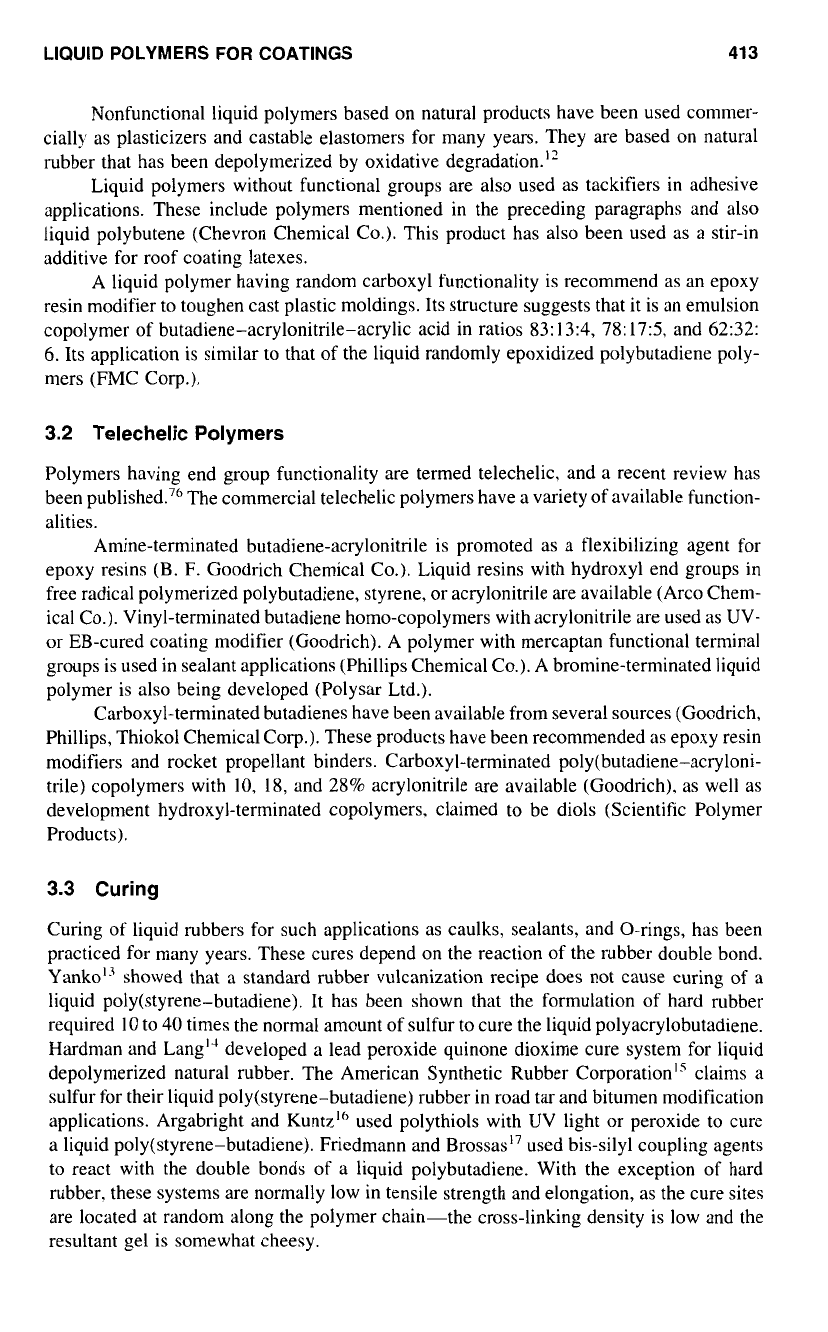
LIQUID
POLYMERS
FOR
COATINGS
41
3
Nonfunctional liquid polymers based on natural products have been used commer-
cially as plasticizers and castable elastomers for many years. They are based on natural
rubber that has been depolymerized by oxidative degradation."
Liquid polymers without functional groups are also used as tackifiers
in
adhesive
applications. These include polymers mentioned in the preceding paragraphs and also
liquid polybutene (Chevron Chemical Co.). This product has also been used as a stir-in
additive for roof coating latexes.
A liquid polymer having random carboxyl functionality is recommend as an epoxy
resin modifier to toughen cast plastic moldings. Its structure suggests that it is an emulsion
copolymer of butadiene-acrylonitrile-acrylic acid in ratios 83:
13:4,
78: 175, and 62:32:
6. Its application is similar to that
of
the liquid randomly epoxidized polybutadiene poly-
mers (FMC Corp.).
3.2
Telechelic Polymers
Polymers having end group functionality are termed telechelic, and a recent review has
been published." The commercial telechelic polymers have a variety of available function-
alities.
Amine-terminated butadiene-acrylonitrile is promoted as a flexibilizing agent for
epoxy resins
(B.
F.
Goodrich Chemical Co.). Liquid resins with hydroxyl end groups in
free radical polymerized polybutadiene, styrene, or acrylonitrile are available (Arco Chem-
ical Co.). Vinyl-terminated butadiene homo-copolymers with acrylonitrile are used as UV-
or EB-cured coating modifier (Goodrich). A polymer with mercaptan functional terminal
groups is used in sealant applications (Phillips Chemical Co.). A bromine-terminated liquid
polymer is also being developed (Polysar Ltd.).
Carboxyl-terminated butadienes have been available from several sources (Goodrich,
Phillips, Thiokol Chemical Corp.). These products have been recommended as epoxy resin
modifiers and rocket propellant binders. Carboxyl-terminated
poly(butadiene-acryloni-
trile) copolymers with
10, 18,
and 28% acrylonitrile are available (Goodrich), as well as
development hydroxyl-terminated copolymers. claimed
to
be diols (Scientific Polymer
Products).
3.3
Curing
Curing of liquid rubbers for such applications as caulks, sealants, and O-rings, has been
practiced for many years. These cures depend on the reaction of the rubber double bond.
Yanko13 showed that a standard rubber vulcanization recipe does not cause curing
of
a
liquid
poly(styrene-butadiene).
It has been shown that the formulation of hard rubber
required
10
to
40
times the normal amount of sulfur
to
cure the liquid polyacrylobutadiene.
Hardman and LangI4 developed a lead peroxide quinone dioxime cure system for liquid
depolymerized natural rubber. The American Synthetic Rubber Corporationls claims a
sulfur for their liquid poly(styrene-butadiene) rubber in road tar and bitumen modification
applications. Argabright and Kuntzl" used polythiols with UV light or peroxide to cure
a liquid
poly(styrene-butadiene).
Friedmann and Brossas17 used bis-silyl coupling agents
to react with the double bonds of a liquid polybutadiene. With the exception
of
hard
rubber, these systems are normally low in tensile strength and elongation, as the cure sites
are located at random along the polymer chain-the cross-linking density is low and the
resultant gel is somewhat cheesy.
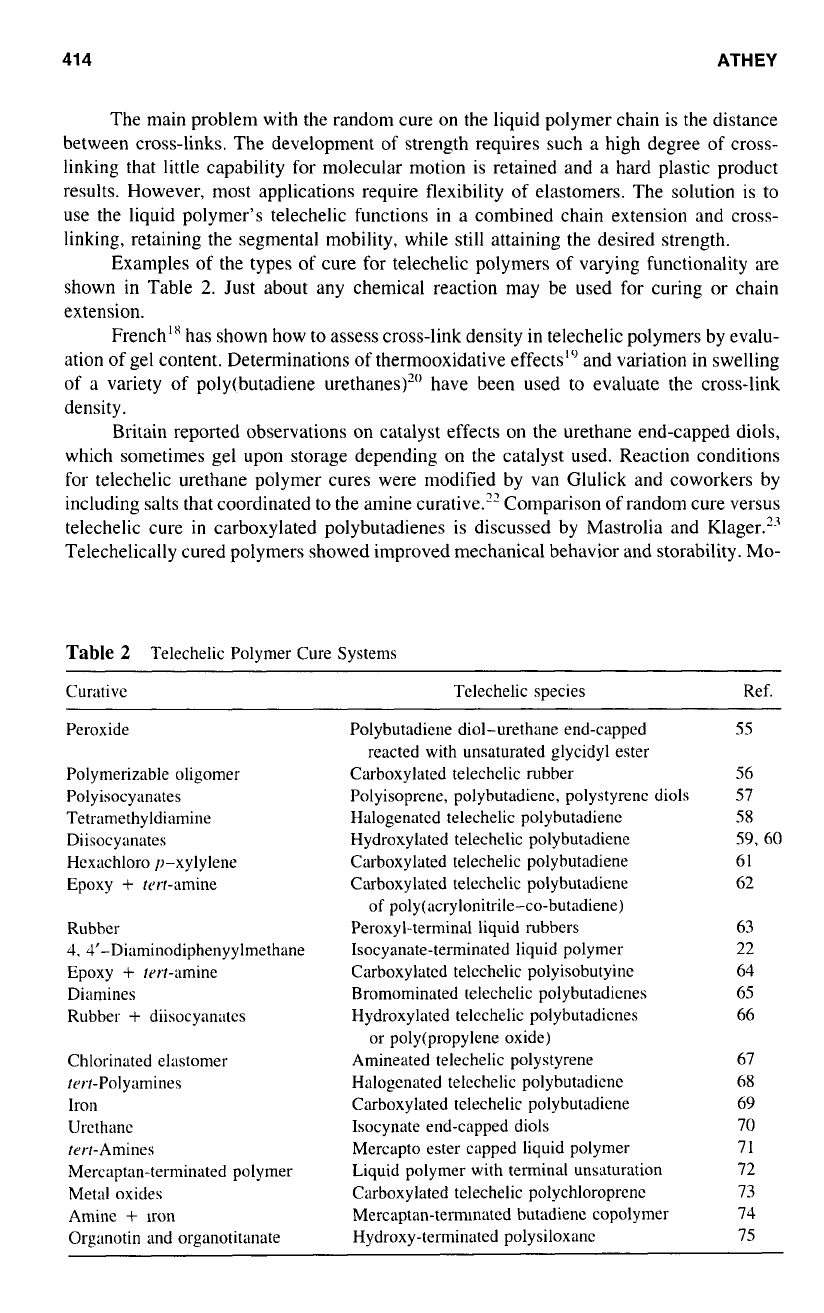
414
ATHEY
The main problem with the random cure on the liquid polymer chain is the distance
between cross-links. The development of strength requires such
a
high degree of cross-
linking that little capability for molecular motion is retained and a hard plastic product
results. However, most applications require flexibility of elastomers. The solution is to
use the liquid polymer's telechelic functions
in
a combined chain extension and cross-
linking, retaining the segmental mobility, while still attaining the desired strength.
Examples of the types of cure for telechelic polynlers
of
varying functionality are
shown in Table
2.
Just about any chemical reaction may be used for curing or chain
extension.
Frenchlx has shown how
to
assess cross-link density in telechelic polymers by evalu-
ation of gel content. Determinations
of
thermooxidative effects'" and variation in swelling
of a variety
of
poly(butadiene urethanes)'" have been used to evaluate the cross-link
density.
Britain reported observations on catalyst effects
on
the urethane end-capped diols,
which sometimes gel upon storage depending
on
the catalyst used. Reaction conditions
for telechelic urethane polymer cures were modified by van Glulick and coworkers by
including salts that coordinated
to
the amine curative." Comparison of random cure versus
telechelic cure
in
carboxylated polybutadienes is discussed by Mastrolia and Klager."
Telechelically cured polymers showed improved mechanical behavior and storability.
Mo-
Table
2
Telechelic Polymer Cure Systems
Curative Tclechelic species Ref.
Peroxide
Polymerizable oligomer
Polyisocyanates
Tetramethyldiamine
Diisocyanates
Hcxachloro p-xylylene
Epoxy
+
fer/-amine
Rubber
4.
4'-Diaminodiphenyylmethane
Epoxy
+
/err-amine
Diamines
Rubber
+
diisocyanatcs
Chlorinated elastomer
fwr-Polyamines
Iron
Urcthanc
terf-Amines
Mercaptan-terminated polymer
Metal oxides
Amine
+
iron
Orgnnotin and organotitanate
Polybutadiene diol-urethane end-capped
reacted
with
unsaturated glycidyl ester
Carboxylated telechclic rubber
Polyisoprenc, polybutadicnc, polystyrenc
diols
Halogenated telechelic polybutadienc
Hydroxylated telechclic polybutadiene
Carboxylated telechelic polybutadiene
Carboxylated telcchelic polybutadicne
of
poly(ncrylonitrile-eo-butadiene)
Peroxyl-terminal liquid rubbers
Isocyanate-terminated liquid
polymer
Carboxylated telcchclic polyisobutyinc
Brornominated telechelic polybutadicnes
Hydroxylated telcchelic polybut
a
d'
lcnes
Arnineated telechelic polystyrene
Halogenated telcchelic polybutadicnc
Carboxylated telechelic polybutadicne
Isocynate end-capped diols
Mercapto ester capped liquid polymer
Liquid polymer with terminal unsaturation
Carboxylated tclechelic polychloroprenc
Mercaptan-terminated butadiene copolymer
Hydroxy-terminated polysiloxanc
or poly(propy1ene oxide)
ss
S6
S7
S8
59,
60
61
62
63
22
64
65
66
67
68
69
70
71
72
73
74
75
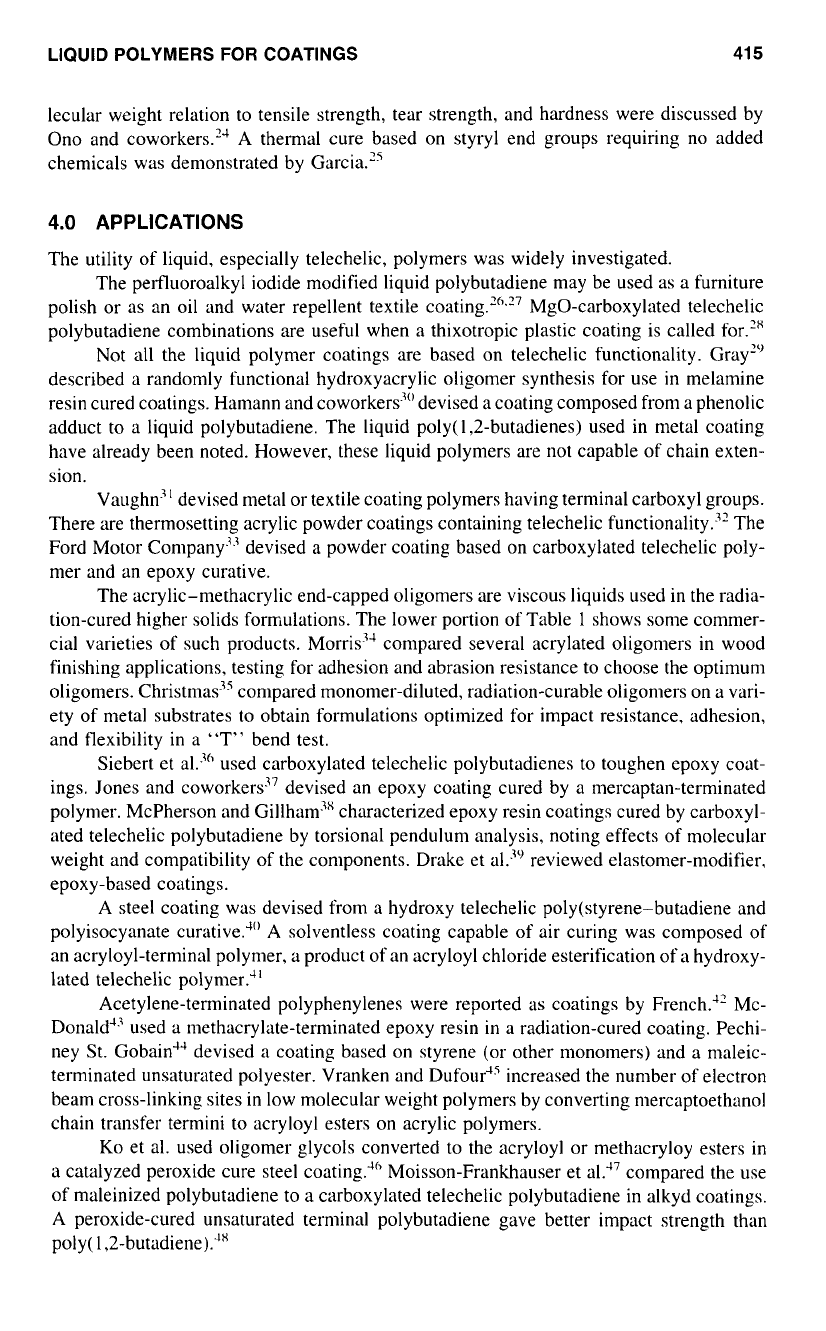
LIQUID
POLYMERS
FOR
COATINGS
41
5
lecular weight relation to tensile strength, tear strength, and hardness were discussed by
Ono and coworkers.'' A thermal cure based on styryl end groups requiring no added
chemicals was demonstrated by Garcia."
4.0
APPLICATIONS
The utility of liquid, especially telechelic, polymers was widely investigated.
The peffluoroalkyl iodide modified liquid polybutadiene may be used as a furniture
polish or as an oil and water repellent textile ~oating.".'~ MgO-carboxylated telechelic
polybutadiene combinations are useful when a thixotropic plastic coating is called for."
Not all the liquid polymer coatings are based on telechelic functionality. Gray'"
described a randomly functional hydroxyacrylic oligomer synthesis for use in melamine
resin cured coatings. Hamann and coworkers3" devised a coating composed from a phenolic
adduct
to
a liquid polybutadiene. The liquid poly( 1,2-butadienes) used in metal coating
have already been noted. However, these liquid polymers are not capable of chain exten-
sion.
Vaughn3' devised metal or textile coating polymers having terminal carboxyl groups.
There are thermosetting acrylic powder coatings containing telechelic functionality.3' The
Ford Motor devised a powder coating based on carboxylated telechelic poly-
mer and an epoxy curative.
The acrylic-methacrylic end-capped oligomers are viscous liquids used in the radia-
tion-cured higher solids formulations. The lower portion of Table
l
shows some commer-
cial varieties
of
such products. Morris3' compared several acrylated oligomers
in
wood
finishing applications, testing
for
adhesion and abrasion resistance to choose the optimum
oligomers. Christmas35 compared monomer-diluted, radiation-curable oligomers on a vari-
ety of metal substrates to obtain formulations optimized for impact resistance, adhesion,
and flexibility
in
a "T" bend test.
Siebert et a1.j" used carboxylated telechelic polybutadienes to toughen epoxy coat-
ings. Jones and coworkers37 devised an epoxy coating cured by a mercaptan-terminated
polymer. McPherson and Gillham"s characterized epoxy resin coatings cured by carboxyl-
ated telechelic polybutadiene by torsional pendulum analysis, noting effects of molecular
weight and compatibility
of
the components. Drake et a1.j" reviewed elastomer-modifier,
epoxy-based coatings.
A steel coating was devised from a hydroxy telechelic poly(styrene-butadiene and
polyisocyanate curative.'" A solventless coating capable
of
air curing was composed of
an acryloyl-terminal polymer, a product of an acryloyl chloride esterification
of
a
hydroxy-
lated telechelic polymer."
Acetylene-terminated polyphenylenes were reported
as
coatings by French.'' Mc-
Donald" used a methacrylate-terminated epoxy resin in a radiation-cured coating. Pechi-
ney St. Gobain" devised a coating based
on
styrene (or other monomers) and a maleic-
terminated unsaturated polyester. Vranken and Dufo1d5 increased the number of electron
beam cross-linking sites
in
low molecular weight polymers by converting mercaptoethanol
chain transfer termini
to
acryloyl esters on acrylic polymers.
KO
et al. used oligomer glycols converted to the acryloyl or methacryloy esters in
a catalyzed peroxide cure steel coating.'" Moisson-Frankhauser et al.'7 compared the use
of maleinized polybutadiene
to
a carboxylated telechelic polybutadiene in alkyd coatings.
A peroxide-cured unsaturated terminal polybutadiene gave better impact strength than
poly( 1,2-b~tadiene).~'
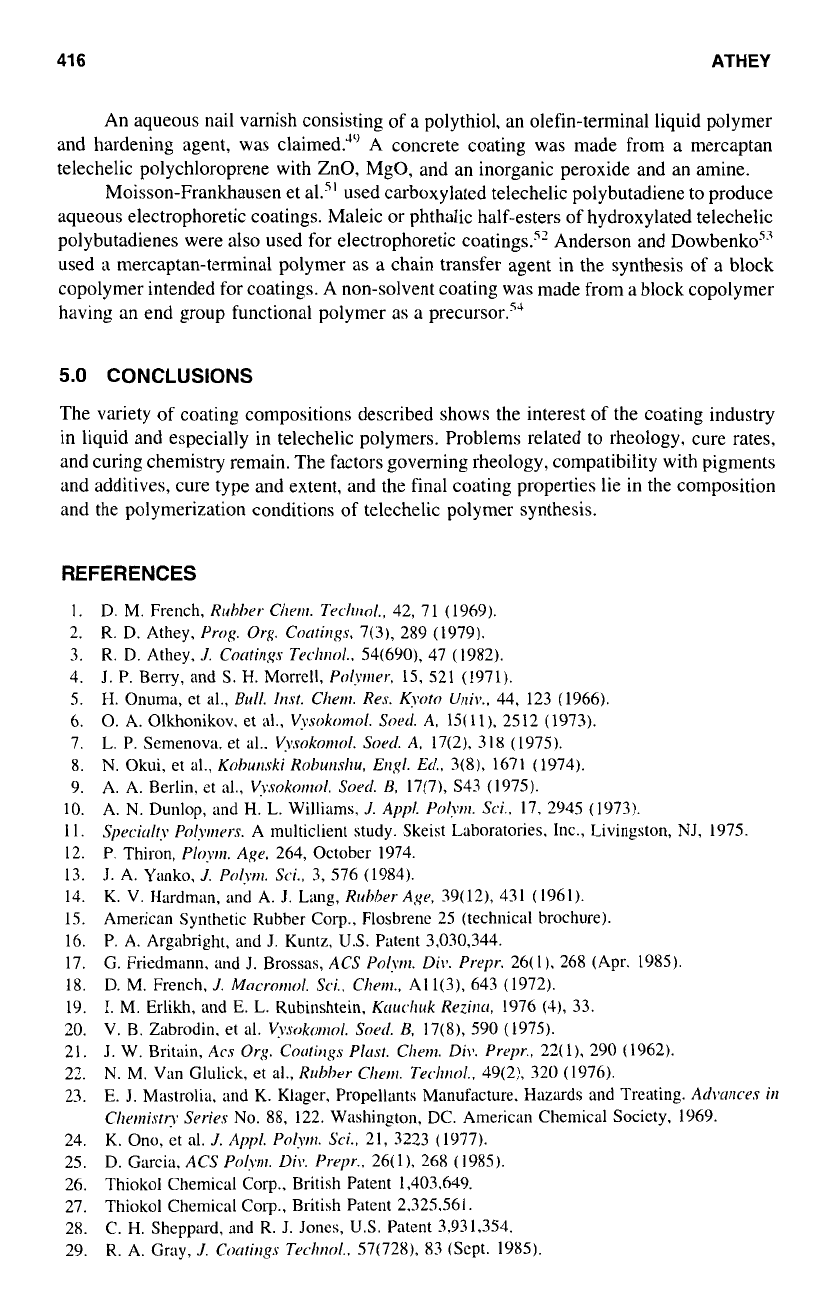
41
6
ATHEY
An aqueous nail varnish consisting of a polythiol, an olefin-terminal liquid polymer
and hardening agent, was claimed:" A concrete coating was made from a mercaptan
telechelic polychloroprene with ZnO, MgO, and an inorganic peroxide and an amine.
Moisson-Frankhausen et al." used carboxylated telechelic polybutadiene
to
produce
aqueous electrophoretic coatings. Maleic or phthalic half-esters of hydroxylated telechelic
polybutadienes were also used for electrophoretic coatings5' Anderson and Dowbenko'j
used
a
mercaptan-terminal polymer as a chain transfer agent in the synthesis of a block
copolymer intended for coatings. A non-solvent coating was made from a block copolymer
having an end group functional polymer as
a
precursor.5J
5.0
CONCLUSIONS
The variety of coating compositions described shows the interest
of
the coating industry
in liquid and especially in telechelic polymers. Problems related to rheology, cure rates.
and curing chemistry remain. The factors governing rheology, compatibility with pigments
and additives, cure type and extent, and the final coating properties lie in the composition
and the polymerization conditions
of
telechelic polymer synthesis.
REFERENCES
1.
D.
M.
French,
Rubher
Cherr~.
Teclrnol.,
42, 71 (1969).
2.
R.
D.
Athey,
Pros.
Org.
Cocrfirrgs.
7(3), 289 (1979).
3.
R.
D.
Athey,
J.
Conti~gs
Techol..
54(690), 47 (1982).
4.
J.
P. Berry, and
S.
H. Morrcll,
Polymer-.
15,
521
(1971).
S.
H.
Onuma, et
al.,
Bull.
ht.
Cherrl.
Res.
Kyoto
Univ.,
44, 123 (1966).
6.
0.
A. Olkhonikov. et
al.,
Vysokomol.
Soed.
A,
15(
1
l),
2512 (1973).
7.
L. P. Scmenova, et al..
V~snkorml.
Soed
A,
17(2),
318
(1975).
8.
N.
Okui,
et al.,
Kohur~ski
Kohur~~sl~u,
En'gl.
Ed.,
3(8),
1671 (1974).
9.
A. A. Berlin, et
al.,
Vv.sokomol.
Soerl.
B,
17(7), S43 (1975).
10.
A.
N.
Dunlop, and H. L. Williams,
J.
Appl.
Polyru.
Sei..
17, 2945 (1973).
11.
Specitrlfy
Po/w~er.s.
A multiclient study. Skeist Laboratories. Inc., Livingston, NJ,
1975.
12.
P. Thiron,
Ployrr~.
A<ge.
264,
October
1974.
13.
J.
A. Yanko,
J.
Po/yn~.
Sci..
3,
576 (1984).
14.
K. V. Hardman, and A.
J.
Lnng,
RuhherA,ge,
39(12),
431
(1961).
15.
American Synthetic Rubber Corp., Flosbrene
25
(technical brochure).
16.
P. A. Argabright, and J. Kuntz,
U.S.
Patent
3.030,344.
17.
G.
Friedmann,
and
J.
Brossas,
ACS
Po/ym.
D~Y.
Prepr.
26(
I).
268
(Apr.
1985).
18.
D.
M.
French,
J.
Mncro~rrol.
Sci..
Chem.,
AI
1(3),
643
(
1972).
19.
I.
M. Erlikh, and
E.
L.
Rubinshtein,
Ktruchk
Rezirlrc,
1976
(4),
33.
20.
V. B. Zabrodin. et al.
V~wkor~~ol.
Soed.
B.
17(8), 590 (1975).
21.
J.
W. Britain,
Acs
Or-g.
Cotrtings
Pltrst.
Cl~em.
D;\,.
Prepr.,
22(
I),
290 (1962).
22.
N.
M.
Van Glulick,
et
al.,
Rdhr
C'/~em.
Tec.hr~o/.,
49(2),
320
(1976).
23.
E.
J.
Mastrolia,
and
K.
Klagcr, Propellants Manufacture. Hazards and Treating.
Adwrnces
in
24.
K. Ono, et al.
J.
App/.
Po/ym.
Sci.,
21,
3223 (1977).
25.
D.
Garcia.
ACS
Po/yrn.
Di\v.
Prepr..
26(1),
268 (1985).
26.
Thiokol Chemical Corp., British Patent
1,403549.
27.
Thiokol Chemical Corp., British Patent
2.325.561.
28.
C. H. Sheppard, and R.
J.
Jones,
U.S.
Patent
3,931.354.
29.
R. A. Gray,
J. Cocrfirrgs
Techno/..
57(728),
83
(Sept.
1985).
Cherrlisfr?
Series
No.
88,
122.
Washington, DC. American Chemical Socicty.
1969.
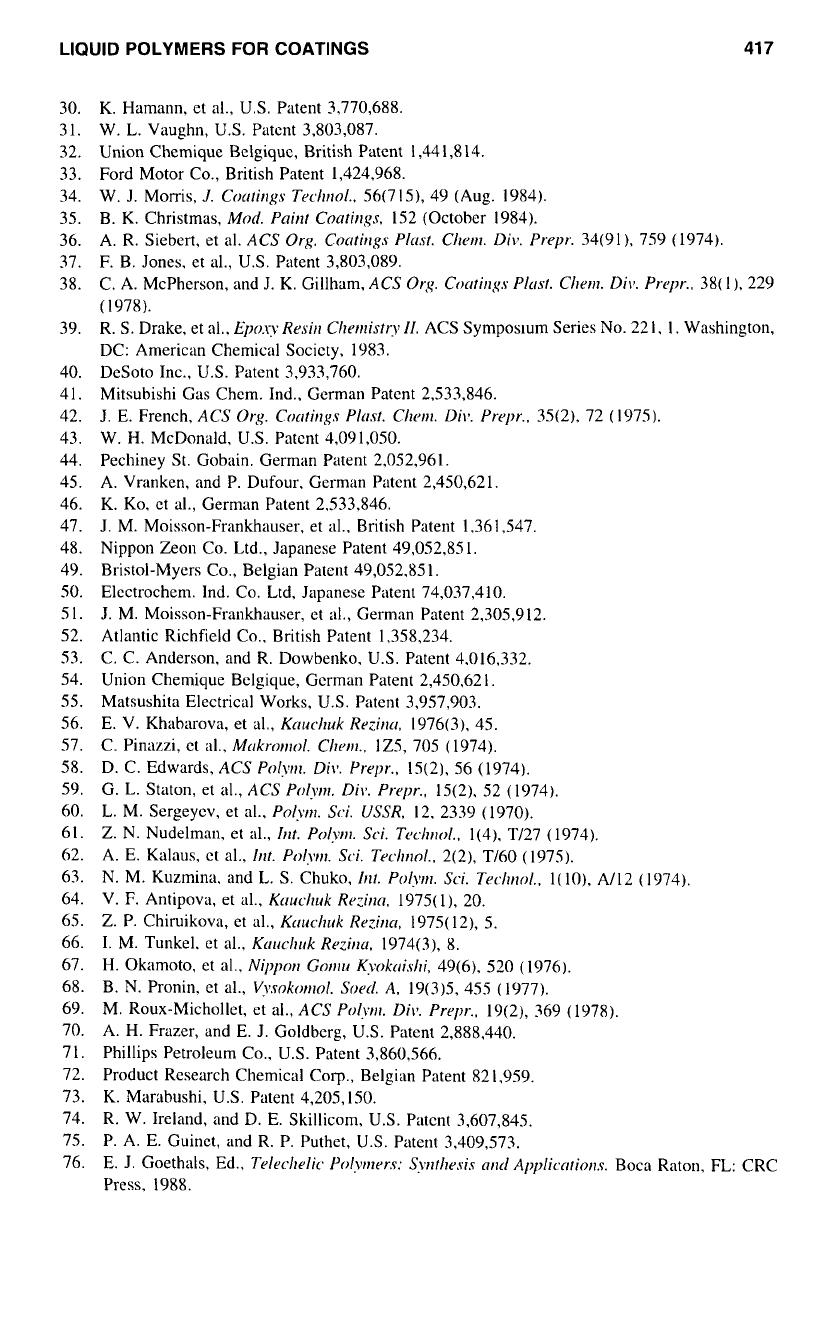
LIQUID
POLYMERS
FOR
COATINGS
41
7
30.
31.
32.
33.
34.
35.
36.
37.
38.
39.
40.
41.
42.
43.
44.
45.
46.
47.
48.
49.
50.
51.
52.
53.
54.
55.
56.
57.
58.
59.
60.
61.
62.
63.
64.
65.
66.
67.
68.
69.
70.
71.
72.
73.
74.
75.
76.
K. Hamann, et
al..
U.S.
Patent
3,770,688.
W.
L.
Vaughn, U.S. Patcnt
3,803,087.
Union Chemique Belgiquc, British Patent
1,441,814.
Ford Motor Co., British Patent
1,424,968.
W.
J.
Morris,
J.
Corrtirlgs
Teckrmk..
56(7
IS),
49
(Aug.
1984).
B. K. Christmas,
Mod.
Paint
Contir~gs.
152
(Octobcr
1984).
A. R. Siebcrt, et al. ACS
Org.
Corttings
Pkrrst.
Clwn.
D~I-.
Prepr.
34(91
),
759 (1974).
F. B. Jones. et
al.,
U.S.
Patent
3,803,089.
C.
A.
McPhcrson, and
J.
K. Gillham.
ACS
Org.
Corrtir~gs
Plrrst.
Clrern.
Div.
Prcy..
38(
1
),
229
(1978).
R.
S.
Drake, et al..
Epo.\:v
Resit1
Cherrlistry
11.
ACS Symposlum Series No.
22
I,
I.
Washington,
DC: American Chemical Socicty.
1983.
DeSoto Inc.,
U.S.
Patent
3,933,760.
Mitsubishi Gas Chcm. Ind., German Patcnt
2,533,846.
J. E. French, ACS
Org.
Coatirlgs
Plrtst.
Clwn. Div.
Prepr.,
35(2), 72 (1975).
W. H. McDonald.
U.S.
Patcnt
4,091,050.
Pechiney St. Gobain. German Patent
2,052,961.
A. Vranken, and
P.
Dufour. German Patent
2,450,621.
K. KO,
et
al., German Patent
2.533.846.
J.
M.
Moisson-Frankhauser, et
al.,
British Patent
1,361,547.
Nippon Zeon Co. Ltd., Japanese Patent
49,052,85
I.
Bristol-Myers Co., Belgian Patent
49,052.85
1.
Elcctrochem. Ind. Co. Ltd. Japanese Patent
74,037.410.
J.
M.
Moisson-Frankhauser, ct
al.,
German Patent
2,305,912.
Atlantic Richfield Co.. British Patent
1,358,234.
C.
C. Anderson, and R. Dowbenko,
U.S.
Patent
4.016.332.
Union Chemique Bclgique, Gcrman Patent
2,450.62
1.
Matsushita Electrical Works,
U.S.
Patent
3,957,903.
E. V. Khabarova, et
al.,
Krruchuk
Rezirltr.
1976(3). 45.
C. Pinazzi,
et
al.,
Mrrkromjk.
Clwu..
1Z5,
705 (1974).
D. C. Edwards, ACS
Polytu.
Div.
Prepr.,
15(2),
56
(1974).
G. L. Staton, et
al.,
ACS
Po/ym.
Di18.
Pwpr.,
132).
52
(1974).
L.
M.
Sergeycv,
et
al..
Polym.
Sci.
USSR,
12. 2339 (1970).
Z.
N. Nudelman, et
al.,
Int.
Pokym.
Sei.
Tcxhrtol.,
l(4). T/27 (1974).
A.
E. Kalaus, ct al.,
hr.
Pokym.
Sei,
Techr~ok..
2(2),
T/60
(1975).
N. M. Kuzmina. and L.
S.
Chuko,
In/.
Pokym.
Sei.
Tdrml.,
l(
IO),
A/12
(
1974).
V.
F. Antipova, et
al.,
Krruchuk
Rezir~n.
1975(
l),
20.
Z.
P. Chiruikova, et
al.,
Krruchuk Rezitla,
1975( 12),
5.
I.
M. Tunkel. et
al.,
Krruchrtk
Rezim,
1974(3), 8.
H. Okamoto, et al.,
Nippr
Gomu
Kyokrrislri,
49(6),
520
(1976).
B. N. Pronin, et al.,
Vvsokon~ol.
Soed
A.
19(3)5, 455
(
1977).
M. Roux-Michollet, et al., ACS
Pokym.
Div.
Prepr..
19(2), 369 (1978).
A. H. Frazer, and E.
J.
Goldberg,
U.S.
Patent
2,888,440.
Phillips Petroleum Co.,
U.S.
Patent
3,860,566.
Product Rcsearch Chemical Corp., Belgian Patent
82 1,959.
K. Marabushi,
U.S.
Patent
4,205,150.
R. W. Ireland, and D. E. Skillicom,
U.S.
Patcnt
3,607,845.
P. A. E. Guinet, and R.
P.
Puthet,
U.S.
Patcnt
3,409,573.
E.
J.
Goethals, Ed.,
Teleclrukic
Po/yrwr.s:
Synthesis
nrd
Applicntior1.y. Boca Raton, FL: CRC
Press.
1988.
This Page Intentionally Left Blank
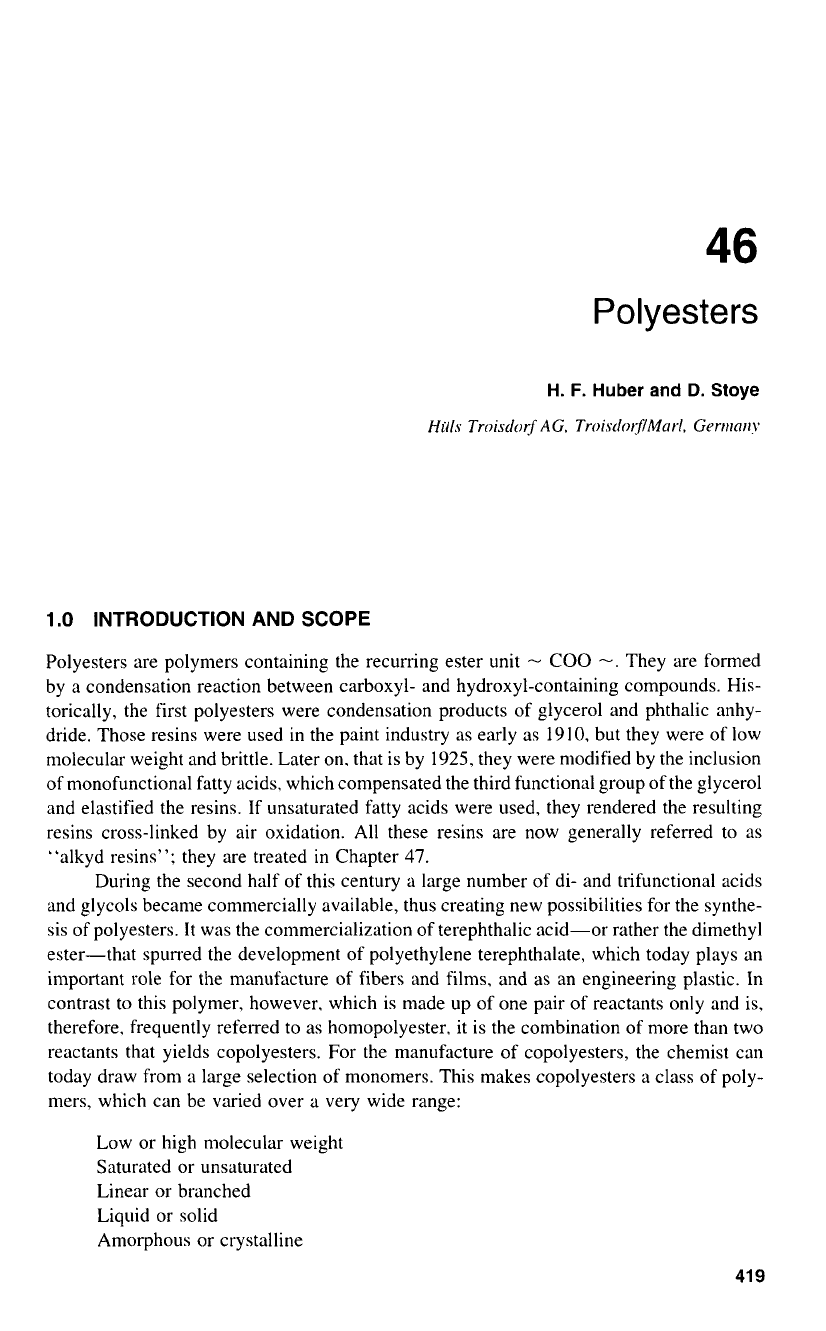
Polyesters
H.
F.
Huber and
D.
Stoye
Hills
Troisrlorj
AG.
TroisdorflMarl,
Genrmry
1
.O
INTRODUCTION AND SCOPE
Polyesters are polymers containing the recurring ester unit
-
COO
-.
They are formed
by a condensation reaction between carboxyl- and hydroxyl-containing compounds. His-
torically, the first polyesters were condensation products of glycerol and phthalic anhy-
dride. Those resins were used in the paint industry as early as 1910, but they were of low
molecular weight and brittle. Later
on.
that is by 1925, they were modified by the inclusion
of
monofunctional fatty acids. which compensated the third functional group of the glycerol
and elastified the resins.
If
unsaturated fatty acids were used, they rendered the resulting
resins cross-linked by air oxidation. All these resins are now generally referred to as
"alkyd resins"; they are treated in Chapter
47.
During the second half of this century a large number
of
di- and trifunctional acids
and glycols became commercially available, thus creating new possibilities for the synthe-
sis of polyesters.
It
was the commercialization of terephthalic acid-or rather the dimethyl
ester-that spurred the development of polyethylene terephthalate, which today plays an
important role for the manufacture of fibers and films, and
as
an engineering plastic. In
contrast
to
this polymer, however. which is made up of one pair of reactants only and is,
therefore. frequently referred to as homopolyester. it is the combination of more than two
reactants that yields copolyesters. For the manufacture of copolyesters, the chemist can
today draw from
a
large selection of monomers. This makes copolyesters
a
class of poly-
mers, which can be varied over a vely wide range:
Low or high molecular weight
Saturated or unsaturated
Linear or branched
Liquid or solid
Amorphous or crystalline
41
9
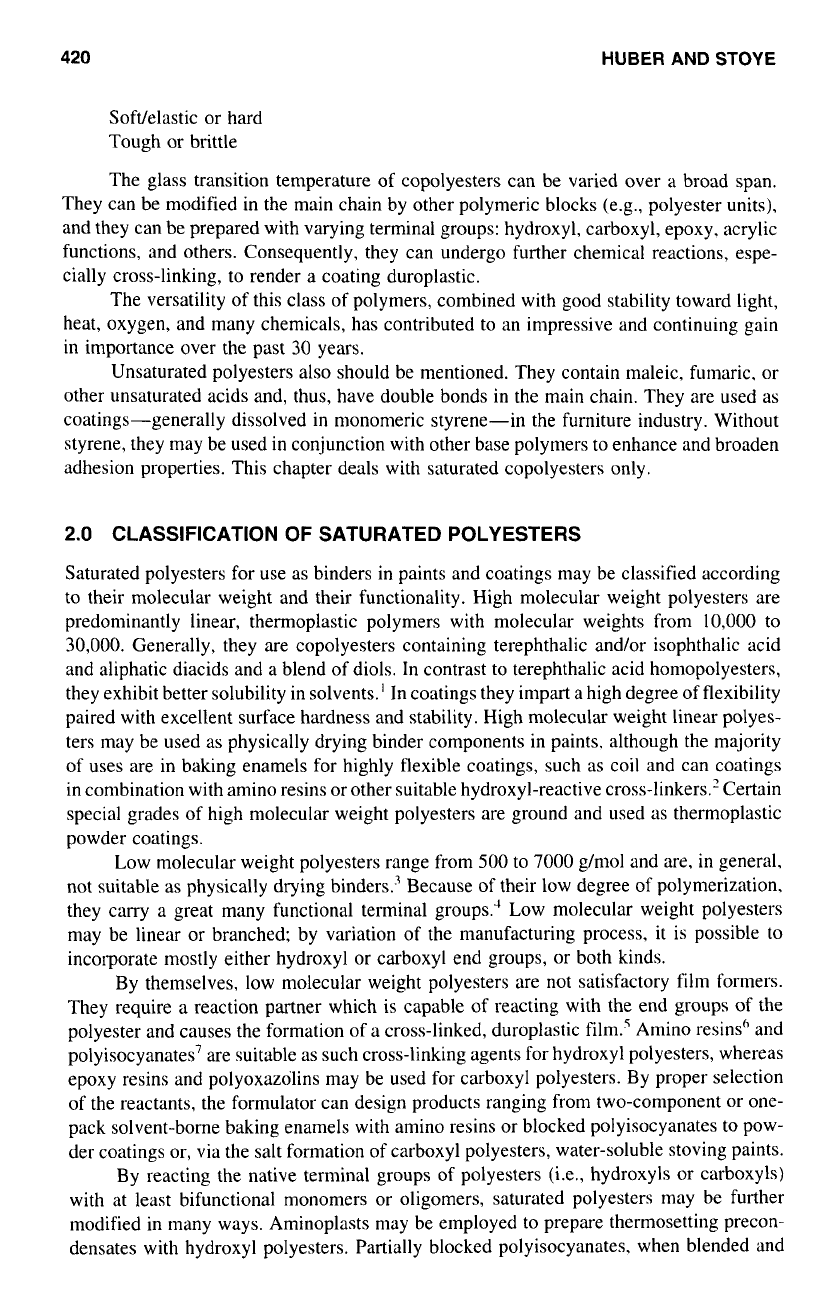
420
HUBER
AND
STOYE
SofVelastic or hard
Tough or brittle
The glass transition temperature of copolyesters can be varied over a broad span.
They can be modified in the main chain by other polymeric blocks (e.g., polyester units),
and they can be prepared with varying terminal groups: hydroxyl, carboxyl, epoxy. acrylic
functions, and others. Consequently, they can undergo further chemical reactions, espe-
cially cross-linking, to render a coating duroplastic.
The versatility of this class of polymers, combined with good stability toward light,
heat, oxygen, and many chemicals, has contributed to an impressive and continuing gain
in importance over the past
30
years.
Unsaturated polyesters also should be mentioned. They contain maleic. fumaric, or
other unsaturated acids and, thus, have double bonds in the main chain. They are used as
coatings-generally dissolved in monomeric styrene-in the furniture industry. Without
styrene, they may be used in conjunction with other base polymers to enhance and broaden
adhesion properties. This chapter deals with saturated copolyesters only.
2.0
CLASSIFICATION OF SATURATED POLYESTERS
Saturated polyesters for use as binders in paints and coatings may be classified according
to their molecular weight and their functionality. High molecular weight polyesters are
predominantly linear, thermoplastic polymers with molecular weights from
10,000
to
30,000.
Generally, they are copolyesters containing terephthalic and/or isophthalic acid
and aliphatic diacids and a blend of diols. In contrast to terephthalic acid homopolyesters,
they exhibit better solubility in solvents.' In coatings they impart a high degree
of
flexibility
paired with excellent surface hardness and stability. High molecular weight linear polyes-
ters may be used as physically drying binder components in paints, although the majority
of
uses are in baking enamels for highly flexible coatings, such as coil and can coatings
in combination with amino resins or other suitable hydroxyl-reactive cross-linkers.' Certain
special grades of high molecular weight polyesters are ground and used
as
thermoplastic
powder coatings.
Low molecular weight polyesters range from
500
to
7000
g/mol and are, in general,
not suitable as physically drying binders? Because
of
their low degree
of
polymerization.
they carry a great many functional terminal groups.' Low molecular weight polyesters
may be linear or branched; by variation of the manufacturing process, it is possible
to
incorporate mostly either hydroxyl or carboxyl end groups, or both kinds.
By themselves, low molecular weight polyesters are not satisfactory film formers.
They require a reaction partner which is capable
of
reacting with the end groups
of
the
polyester and causes the formation of a cross-linked, duroplastic film.' Amino resins" and
polyisocyanates' are suitable as such cross-linking agents for hydroxyl polyesters, whereas
epoxy resins and polyoxazolins may be used for carboxyl polyesters. By proper selection
of the reactants, the formulator can design products ranging from two-component or one-
pack solvent-borne baking enamels with amino resins or blocked polyisocyanates to pow-
der coatings or, via the salt formation of carboxyl polyesters, water-soluble stoving paints.
By reacting the native terminal groups of polyesters (i.e., hydroxyls or carboxyls)
with at least bifunctional monomers or oligomers, saturated polyesters may be further
modified in many ways. Aminoplasts may be employed to prepare thermosetting precon-
densates with hydroxyl polyesters. Partially blocked polyisocyanates. when blended and
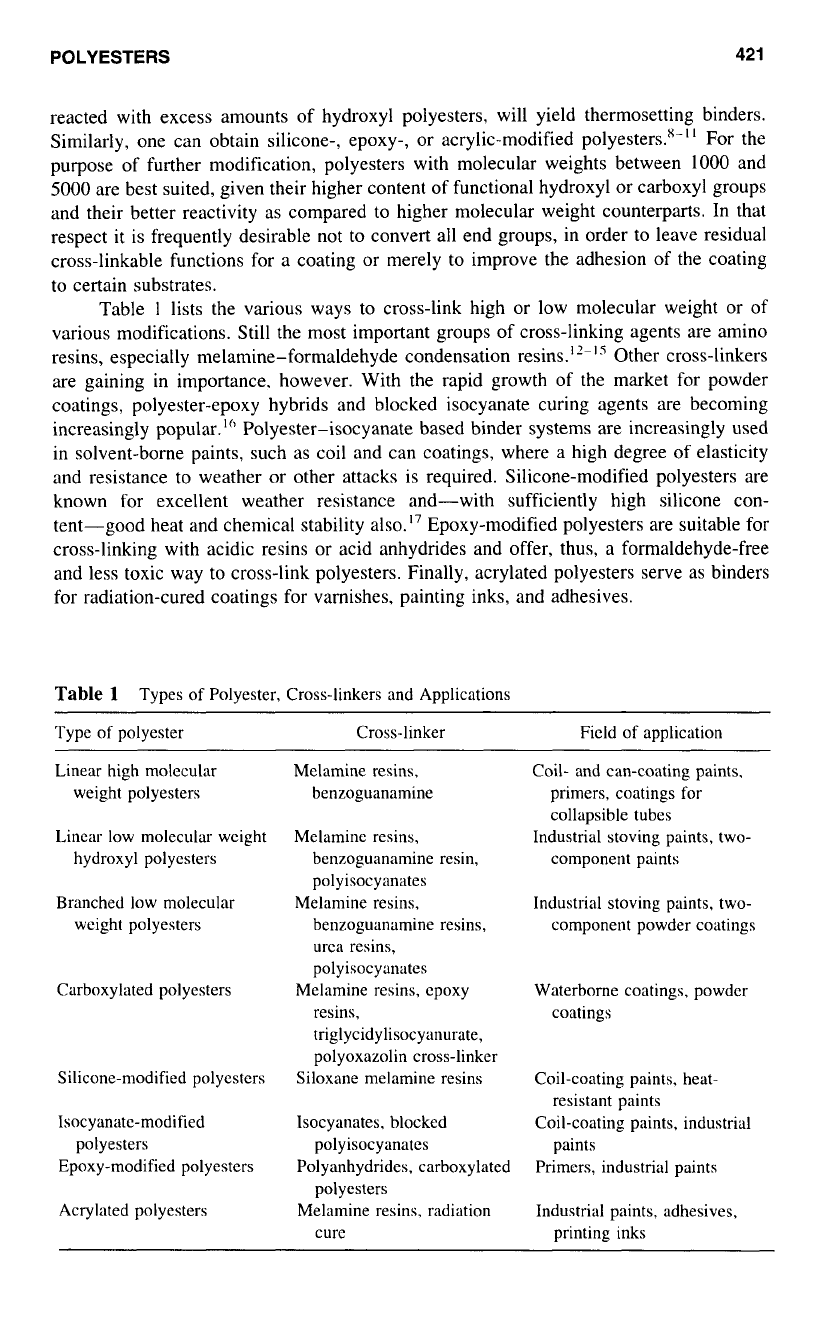
POLYESTERS
421
reacted with excess amounts of hydroxyl polyesters, will yield thermosetting binders.
Similarly, one can obtain silicone-, epoxy-, or acrylic-modified polyesters.'-" For the
purpose of further modification, polyesters with molecular weights between
1000
and
5000
are best suited, given their higher content of functional hydroxyl or carboxyl groups
and their better reactivity
as
compared to higher molecular weight counterparts. In that
respect it is frequently desirable not to convert all end groups, in order to leave residual
cross-linkable functions for a coating or merely to improve the adhesion
of
the coating
to certain substrates.
Table
1
lists the various ways to cross-link high or low molecular weight or of
various modifications. Still the most important groups of cross-linking agents are amino
resins, especially melamine-formaldehyde condensation resins.'"'' Other cross-linkers
are gaining in importance. however. With the rapid growth of the market for powder
coatings, polyester-epoxy hybrids and blocked isocyanate curing agents are becoming
increasingly popular.'" Polyester-isocyanate based binder systems are increasingly used
in solvent-borne paints, such as coil and can coatings, where
a
high degree
of
elasticity
and resistance to weather or other attacks is required. Silicone-modified polyesters are
known for excellent weather resistance and-with sufficiently high silicone con-
tent-good heat and chemical stability
also."
Epoxy-modified polyesters are suitable for
cross-linking with acidic resins or acid anhydrides and offer, thus, a formaldehyde-free
and less toxic way to cross-link polyesters. Finally, acrylated polyesters serve
as
binders
for radiation-cured coatings for varnishes, painting inks, and adhesives.
Table
1
Types of Polyester, Cross-linkers and Applications
Type
of
polyester Cross-linker Field of application
Linear high molecular
weight polyesters
Linear low molecular weight
hydroxyl polyesters
Branched low molecular
weight polyesters
Carboxylated polyesters
Silicone-modified polyesters
Isocyanate-modified
Epoxy-modified polyesters
polyesters
Acrylated polyesters
Melamine resins,
benzoguanamine
Melamine resins,
benzoguanamine resin,
polyisocyanates
Melamine resins,
benzoguanamine resins,
urea resins,
polyisocyanates
resins,
triglycidylisocyanurate,
polyoxazolin cross-linker
Siloxane melamine resins
Melamine resins, epoxy
Isocyanates. blocked
polyisocyanates
Polyanhydrides, carboxylated
polyesters
Melamine resins, radiation
cure
Coil- and can-coating paints.
primers, coatings for
collapsible tubes
component paints
Industrial stoving paints, two-
Industrial stoving paints, two-
component powder coatings
Waterborne coatings, powder
coatings
Coil-coating paints, heat-
Coil-coating paints, industrial
Primers, industrial paints
resistant paints
paints
Industrial paints, adhesives,
printing inks
